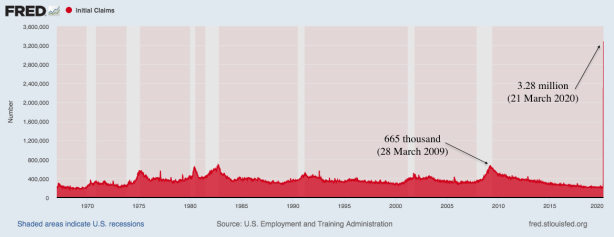From David Ruccio The Labor Department on Thursday reported the number of American workers filing new claims for jobless benefits last week rose to 3.28 million from 282,000 a week earlier. Nothing in the 53-year history of the series comes close. In the worst week of 2009, when the job market was reeling, initial claims hit 665,000. Worse, the millions in new claims don’t reflect all the people who were pushed out of jobs last week as the novel coronavirus crisis emptied out Main Streets, shut businesses down, and impelled many other corporations to curtail their operations and furlough or lay off workers whom they directly or indirectly employ. As Quoctrung Bui and Justin Wolfers explain, be aware that these numbers come with some pretty important caveats. In particular, this
Topics:
David F. Ruccio considers the following as important: Uncategorized
This could be interesting, too:
tom writes The Ukraine war and Europe’s deepening march of folly
Stavros Mavroudeas writes CfP of Marxist Macroeconomic Modelling workgroup – 18th WAPE Forum, Istanbul August 6-8, 2025
Lars Pålsson Syll writes The pretence-of-knowledge syndrome
Dean Baker writes Crypto and Donald Trump’s strategic baseball card reserve
from David Ruccio
The Labor Department on Thursday reported the number of American workers filing new claims for jobless benefits last week rose to 3.28 million from 282,000 a week earlier. Nothing in the 53-year history of the series comes close. In the worst week of 2009, when the job market was reeling, initial claims hit 665,000.
Worse, the millions in new claims don’t reflect all the people who were pushed out of jobs last week as the novel coronavirus crisis emptied out Main Streets, shut businesses down, and impelled many other corporations to curtail their operations and furlough or lay off workers whom they directly or indirectly employ.
As Quoctrung Bui and Justin Wolfers explain,
be aware that these numbers come with some pretty important caveats. In particular, this spike in joblessness is so large that many unemployment offices had trouble keeping up, and in some cases their phone lines and websites have been overloaded. These official numbers reflect the number of claims successfully filed, but the true number of people newly out of work and attempting to file may be much larger. Those who failed to file last week but successfully did so this week will increase the next set of numbers, due out next week.
In addition, when unemployment offices don’t file their numbers on time — and given the surge in applications, it’s likely that data collection is particularly chaotic at the moment — the Labor Department treats these missing data as if there were no jobless claims from that office. Therefore many of these numbers may be undercounts. Furthermore, counts of the number of people claiming benefits are affected by the number who are eligible, and this may be changing rapidly, as the impact of Covid-19 has led some states to expand who can claim unemployment insurance.

